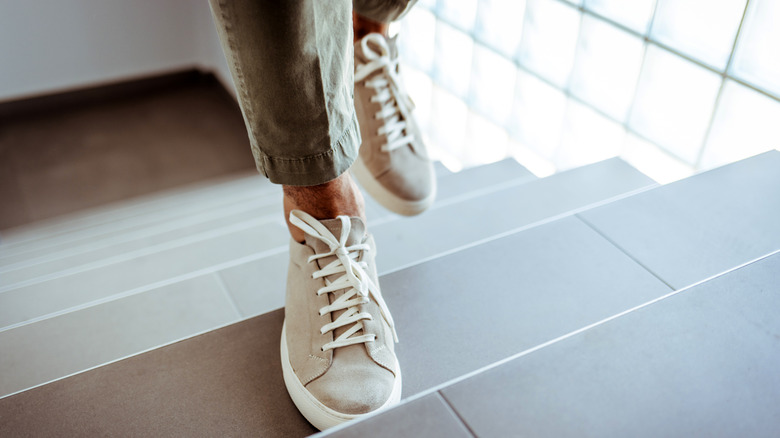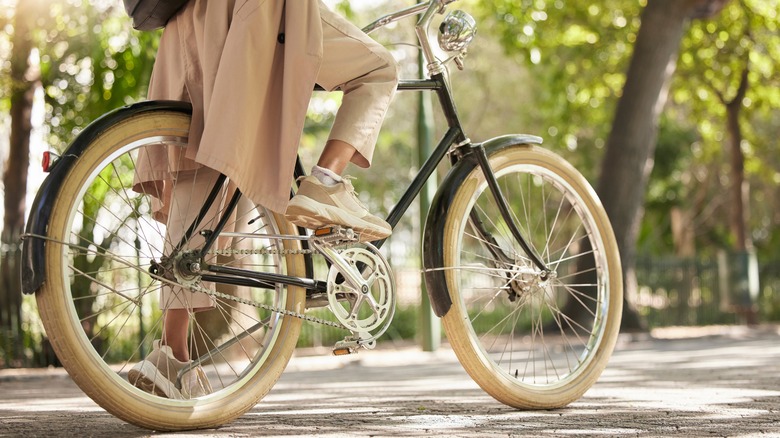Easy Ways To Turn Your Daily Errands Into Exercise
A common exercise myth is that the only way to exercise effectively is by putting in a full hour at a gym (via American Massage Therapy Association). This can not only discourage someone from attempting to keep up with a regular workout routine, but also lead to the incorrect conclusion that fitting in shorter amounts of exercise during one's daily schedule doesn't do any real good.
But as licensed massage therapist David Madon told the American Massage Therapy Association, there's nothing wrong with splitting up one's exercise into 10-minute sessions. He also specifies that just walking outside (for example) is a perfectly good way to spend those 10 minutes. And there is research supporting Madon's advice. The article cited a study that compared doing smaller 10-minute workouts (involving moderate to vigorous exercise) done over the course of a day to working out at a gym for 60 minutes. The study found that the 60-minute workout and the series of smaller 10-minute workouts were equally effective.
Even though shorter bouts of exercise can still help you reach fitness goals, it can feel difficult to incorporate exercise into your schedule. But with some minor changes and by taking full advantage of your time, you can squeeze different types of exercises into your daily errands. We'll be exploring some of the possible health benefits of these workouts — though as Harvard recommends, before starting an exercise routine, speak with a medical professional, especially if you have a health condition like asthma.
Take the stairs at least some of the time
Malls can be one-stop shopping for running errands. Parents might go to the mall to buy clothes and shoes for their children for school and then stop by the food court or a restaurant in the mall to pick up dinner. It's even possible to find a post office or a grocery store at a mall. But no matter what errands you're running, an easy way to get in some extra exercise is to use the stairs at the mall.
Dr. Kenneth Hunt, the medical director of the UCHealth Foot and Ankle Center – Stapleton in Denver, told U.S. News & World Report that stair climbing can have multiple health benefits, like improving cardiovascular health, muscle strength, and balance. Meanwhile, according to physical therapist Eric Sampsell of The Centers for Advanced Orthopaedics in Hagerstown, Maryland, climbing stairs can also increase energy and reduce the chances of developing health issues like hypertension.
For someone who might not feel their fitness level can handle taking the stairs all the time, registered nurse Polly de Mille told Everyday Health that you can split it up so you're (for example) using the elevator to go up and the stairs to go down. But Dr. Hunt cautions (via U.S. News & World Report) that people with medical concerns like bursitis might want to avoid taking the stairs at all.
Pick a parking space that's not close to the building
While it's normal to try to get a parking space near a supermarket, parking further away forces you to do more walking, via Mayo Clinic. Specifically, walking can lower the odds of developing medical issues like diabetes, hypertension, heart disease, and obesity. However, this doesn't mean you have to pick the last space at the end of the parking lot. Instead, you can park a little further out with each grocery shopping trip, and in the process, gradually increase the number of steps you're taking.
The U.S. Department of Health and Human Services (HHS) has guidelines regarding how much exercise one should get a week and the intensity of that exercise. In general, at least 150 minutes per week of moderate-intense exercise is the rule for adults. Brisk walking is a type of moderate-intense physical activity, and 10-minute sessions of it can go towards the 150-minute weekly goal. And even if brisk walking is a bit too fast for you, adding regular walking to your everyday routine can still be good for your health.
Although increasing how much you walk can be a simple way to exercise more, the Mayo Clinic cautions against trying to walk 10,000 steps a day. While this is a common goal of activity trackers, how many steps one should get daily varies from person to person based on how active they are now and their fitness goals.
Strength training with groceries
So you're going grocery shopping, and you've parked far away from the supermarket to try to get some additional exercise. But even after you've returned home, there's still a way to add another type of workout to this errand.
As Better Health Channel suggests, you can exercise with your groceries as you put them away, and specifically recommends using milk like a weight and lifting it up and down. Additionally, the Mayo Clinic says you can use soup cans instead of free weights when strength training. Strength training can not only increase muscle mass but also strengthen one's bones, improve balance, and help with weight management. Strength training can also lower the chances of having joint injuries and osteoporosis. In addition, patients with conditions like diabetes, arthritis, depression, and heart disease might find strength training beneficial under the supervision of a medical professional.
Despite its potential health benefits, the Mayo Clinic notes that it's possible to injure one's muscles during strength training, especially if one's muscles aren't warmed up first. To help avoid this, you might want to do an aerobic exercise of some kind for five to 10 minutes before strength training. And even if you have to start with something lighter than a gallon of milk in your grocery order, eventually, as you continue strength training, your muscles should become stronger and be able to handle heavier items more easily.
Take your bike instead of your car
When running errands, Better Health Channel suggests considering your transportation options and choosing walking or biking if you can. Of course, if you're going to a supermarket that's far from your home to buy a large amount of food, you'll need a car or an SUV. But if you're just popping down to the local pharmacy to pick up a prescription, then cycling there can be a good way to add some extra exercise to your day.
Physical therapist Dr. Jaclyn Kubiak told the Cleveland Clinic that even if you're new to exercising regularly, starting with cycling can be a good idea since it's low-impact. It can also improve both balance and coordination and be good for the lungs, as well as the heart and blood vessels. Plus, Dr. Kubiak notes that cycling might help with depression and anxiety. Just being outdoors and cycling during errands can be beneficial for one's mind, according to Dr. Kubiak. Additionally, cycling can raise the amount of endorphins in one's body. And as the Cleveland Clinic explains, endorphins can boost one's mood and make one feel happier.
If you want to add cycling to your routine, it's important to have good posture while cycling, including keeping your shoulders back, your neck stretched, and your chin down (via Cleveland Clinic). You should also bend your elbows, but only slightly, and don't tightly grip the handlebars. Also, don't forget to adjust your bike's pedals, seat, and handlebars.
Stuck waiting? Go for a power walk
The next time you're waiting for your dinner order or your clothes at the dry cleaners, instead of taking a seat and going on your smartphone, use the time to exercise. The Mayo Clinic recommends going for a walk while waiting for an appointment, and this idea can also be applied to running errands.
If you only have a limited amount of time to exercise, TODAY notes that power walking might be a better choice than regular walking. Also called brisk walking, this type of exercise not only involves walking faster but also pumping one's arms. Now, let's say that there are two people who each add walking to their errands. One chooses to walk at a normal pace, while the other power walks. Even if both walk for the same amount of time, the person who power walks is more likely to burn larger amounts of calories and tone their muscles more. Also, power walking tends to tone more muscles than regular walking since it engages the muscles in the shoulders, the upper back, and the glutes.
Additionally, according to TODAY, if you counted the number of steps someone who does power walking takes per minute with the number of steps one who does regular walking takes per minute, the number of steps while power walking would be higher. This is why one's heart rate increases more from power walking and why it in particular can be a good exercise for your heart.
Forearm exercise for parents on the go
A common errand for parents is picking up their child or children from school or extracurricular activities. This can involve waiting around killing time in a parked car. However, there's an exercise one can do without leaving the driver's seat.
According to Sharp HealthCare, a way to exercise one's forearms in a car is by squeezing a tennis ball. GoodRx also recommends this exercise and says you should only use your fingers (not your thumb) to squeeze the tennis ball as tightly as possible. This is because this exercise can increase one's crush grip, which, as Healthcare Therapy Services, Inc. specifies, involves just the fingers and the palm. Furthermore, Peak Performance Clinics notes that squeezing a tennis ball might help one avoid developing tennis elbow.
GoodRx also instructs keeping one's elbow at a 90-degree angle and one's palm face up during this exercise. And since Peak Performance Clinics states to place one's forearm on a surface like a table while doing this exercise, you might want to rest your forearm on your thigh if you're in a car. Even though multiple sources recommend this exercise, exactly how long and how many times they recommend squeezing the tennis ball can vary. The shortest amount of time suggested is two seconds (via Sharp HealthCare). The longest amount of time advised is 10 seconds, per Peak Performance Clinics. And the number of reps per hand ranged from 10 to 15.
If you take the bus, get off at a different stop
If you take the bus while doing errands and have some flexibility in your schedule, rather than get off the bus at your usual stop, Better Health Channel suggests getting off at an earlier stop. Even getting off just one stop sooner adds some additional walking to your routine. And if you really want to kick your physical activity up a notch, try running or jogging instead of walking.
According to WebMD, jogging is an excellent form of cardio. To demonstrate how, let's say you change your daily bus riding routine by getting off at an earlier stop and then jogging for 10 minutes to reach the bus stop you would have normally used. That one change could greatly lower your odds of developing cardiovascular disease. Also, running has been shown to increase the size of the part of the brain called the hippocampus, which can improve one's memory. Additionally, jogging can have a beneficial impact on one's mood and boost energy levels. It can also help one get a better night's sleep, unless that person goes jogging late in the day. Then it can actually interfere with sleep.
If you want to add jogging to your errands, it's important to stay hydrated. So, you might want to drink some water on the bus as well as have some with you while you jog and after you're done jogging.








